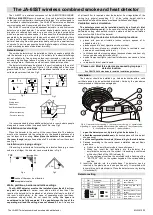
Sea Data
English
5
A few ”do not’s” you should consider:
−
Do not cut cables too short. Allow extra cable length at the instrument so it can be re-
moved for inspection without having to disconnect attached cables.
−
Do not place sealant behind the instrument. The instrument gasket eliminates the need for
sealant.
−
Do not run cables in the bilge, where water can appear.
−
Do not run cables close to the fluorescent light sources, engine or radio transmitting
equipment to avoid electrical disturbances.
−
Do not rush, take your time. A neat installation is easy to do.
•
The following material is needed:
Wire cutters and strippers.
Large Philips and small flat head screw driver.
Hole saw for the instrument clearance hole 63 mm (2
1
/
2
”).
Hole saw for the transducer fitting, hole: 43 mm (1
11
/
16
”).
2.8 mm (
7
/
64
”) drill for the mounting holes
Plastic cable ties.
Silicon sealing for use under water (not supplied)
If you are doubtful about the installation, obtain the services of an experienced technician.
2.1
Installing the instrument
•
Place the adhesive drill template in the desired position for the instrument. Drill the four
screw holes using a 2.8 mm (
7
/
64
”) drill. Use a 63 mm (2
1
/
2
”) hole saw to cut the clearance
hole for the instrument connection socket.
Note! Never drill through the instruments four mounting holes as the gasket may be dam-
aged and thus cause leakage. The warranty is not valid for damage caused by drilling
through the mounting holes.
2.2
Installing transducer
The log and depth transducers need to be positioned carefully. The transducer must remain in
the water at all speeds. Turbulent water causing air bubbles must be avoided.
The best position for the log and depth transducers is as close to the centre line of the boat and
as far forward as possible.
The transducer must always remain submerged in the water.
Power boats:
The waterline of fast power boats shortens considerably
at high speeds. Therefore the transducer should be placed at 25-30%
from the front line of the waterline at full speed.
Sail boats:
Boats with a fin keel must have the transducer located at
least 250 mm (1 ft) but not more than 750 mm (3 ft) in front of the keel,
and no more than 100 mm off the centre. For boats with full-keel it
might be impossible to locate the transducer at the centre line. If the
transducer is off centre, the angle of the paddle wheel should meet the
bow.
The log and depth transducers have the same through hull fitting. De-
cide where to position the transducer and cut a 43 mm (1
11
/
16
”) hole
with a hole saw. Use sand paper to smooth the surface. Clean the sur-
face around the hole on both sides of the hull. Use silicon paste for un-
der water use and spread it on the through hull fitting.


































